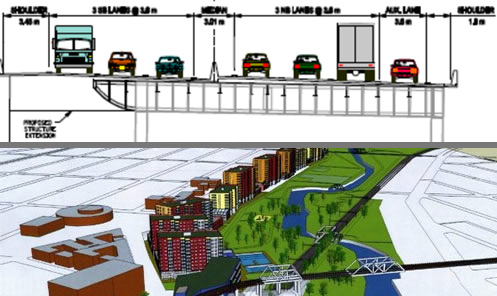$266 Million to Widen the Deegan. Crumbs for a More Livable Bronx River.
 More lanes, or more housing and parks? Image of proposed Deegan Expressway widening: NYSDOT. Image of the community plan for a de-commissioned Sheridan Expressway: SBRWA.
More lanes, or more housing and parks? Image of proposed Deegan Expressway widening: NYSDOT. Image of the community plan for a de-commissioned Sheridan Expressway: SBRWA.Last week we reported on the state DOT’s expensive plan to widen part of the Major Deegan Expressway in the southwest Bronx, even as the agency fails to maintain upstate bridges. The dubious Deegan project sucks up $266 million in the state DOT’s new five-year capital plan, while more promising initiatives — like the potential removal of the Sheridan Expressway — languish without much money at all.
The DOT is considering tearing down the little-used Sheridan, a decision that would clear trucks off local streets and make room for housing, shops, and parks by the Bronx River. But the capital plan sets aside just $2 million for the project. As advocates said in testimony today, that’s only enough cash to muddle through the studies already underway.
To repeat: The capital plan includes $266 million to widen a highway in an asthma-choked area of the Bronx, and $2 million for a project that could dramatically improve neighborhoods pummeled by truck traffic. Addressing a State Senate committee today, advocates made the case for a different approach.
"We call on the NYS DOT to reinstate funding for the Sheridan project by reducing the size and scope of the Major Deegan Expressway project," said the South Bronx River Watershed Alliance in a written statement. "With scarce resources, the agency must do a better job of prioritizing transportation investments that promote the safety, health and well-being of New York City residents."
The Tri-State Transportation Campaign submitted detailed commentary on the full capital plan, which you can read here. Here Tri-State explains why the New York State DOT, which doesn’t expand highways to the same degree as other DOTs, still has a weakness for widening certain types of roads.
NYS DOT often plans large or over built rehabilitation projects under
the guise of "bringing the roadway up to modern design standards."
While certain modern design changes can help improve safety, spending
millions of dollars, in some cases hundreds of millions, to simply
widen interchanges, intersections, or build additional lanes does not
make sense. Such projects often do little to solve congestion in the
long-run, and come with very high price tags at a time when we have no
money to waste.